- Home
- Technical Cooperation Projects
- Index of Countries
- Africa
- Mozambique
- Project on Strengthening Resilience in Cyclone IDAI-Affected Areas
- Project News
- The 1st training in Japan - Sharing successful images of recovery/reconstruction and disaster risk reduction activities as well as developing specific action plans -
Project News
2020-04-30
The 1st training in Japan - Sharing successful images of recovery/reconstruction and disaster risk reduction activities as well as developing specific action plans -
Major counterparts of the ARPOC project, including the Beira Municipality, the Post Cyclone Reconstruction Cabinet (GREPOC) and the National Institute for Disaster Management (INGC), have deepened understanding of the appropriate reconstruction planning based on hazard analysis through a visit to Japan in November 2019 and attendance of Joint Meeting in December 2019.
Besides the ARPOC project plans to support the Beira Municipality to develop a reconstruction action plan, it is crucial to learn successful images on implementing concrete activities and models applicable to Mozambique, especially to Beira City.
In the 1st training in Japan, in order for participants to grasp specific reconstruction and disaster risk reduction activities at the working level, the training program includes the learning topics such as reconstruction plan formulation, the process for considering reconstruction planning and disaster risk reduction activities in Japan. The training was held from February 17 to 28, 2020, for working level officials from the Beira Municipality and local government organizations cooperating with the municipality.
The participants visited the locations below. This training program will be reported in a series of four articles.
Destinations of the training program
- Joso City and Kamisu City, Ibaraki Prefecture
- Sendai City, Ishinomaki City, Shiogama City, Matsushima Town, and Minami-Sanriku Town, Miyagi Prefecture
- Edogawa City, and Katsushika City, Tokyo
Introduction of participants
Ten participants from Mozambique came to Japan for this training.
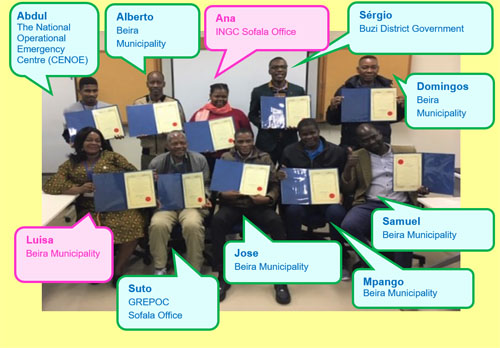
- Domingos: He is a reliable leader for everyone, both in work and private life.
- Samuel: He is in charge of disaster prevention and a leader in planning the one-year commemoration event for Cyclone Idai.
- Mpango: He is responsible for urban development and interested in the latest technologies, such as a drone.
- Jose: He works as a community leader. During the training, he enjoyed his first experience trying Japanese food.
- Suto: He is in charge of onsite reconstruction work. He is calm and logical.
- Luisa: She is responsible for livelihood recovery. She always expresses her appreciation for lecturers.
- Alberto: He is responsible for infrastructure development. He is curious to know the disaster prevention infrastructure in Japan, such as levees.
- Abdul: He is a GIS expert and always asked questions first in Q&A sessions.
- Ana: She is in charge of disaster prevention for the community. She experienced a hot spring for the first time in her life during the training.
- Sérgio: He participated from another disaster-affected city other than Beira City. He is full of passion for disaster recovery and reconstruction.
Understanding the framework of countermeasures against disasters in Japan
Understanding the Japanese administration system (Feb. 17, 2020)
On the first day of training, the participants learned the Japanese administration system and community activity status to deepen their understanding of the subsequent training programs. Mr. Toshiyuki Okui from NOGEZAKA-GLOCAL (a Japanese non-governmental organization) and Ms. Mieko Yoneoka from Hazawa Seibu residents' association in Yokohama City introduced voluntary activities for disaster prevention. Ana, who attended this training from the INGC (responsible for disaster response in Mozambique), asked, "How to collect activity funds for residents' association and volunteer fire corps? How to store food? Is there any training for members involved in disaster risk reduction activities?" The participants understood that there were many volunteer activities in Japan and learned the concepts of "Self Help" and "Mutual Help," which means to consider what actions can be taken at individual and neighborhood association level.
Visit to Joso City (Feb. 18, 2020)
The participants visited Joso City in Ibaraki Prefecture to understand disaster risk reduction activities in response to a torrential rain of September 2015 in the Kanto and Tohoku Regions. They visited the Joso City Office in the morning to learn key points for the establishment of the disaster response system in the office and challenges in raising awareness on disaster risk reduction among citizens.
As shown in the following photo, the city office has used a monitor screen to compile weather information and worked on a unique and down-to-earth activity. By using this monitor screen, every morning, the on-duty city officials analyze the weather conditions of the day to improve their knowledge of disaster and weather, aiming to enhance the office function at the time of disaster. The participants from the Beira Municipality attentively listened to this briefing with interest, as they considered that this work could be immediately implemented on onsite activities in Mozambique.
In the afternoon, they attended lecture sessions provided by Shimodate River Office and Neshinden Neighborhood Association in Joso City. Furthermore, they learned about the efforts and ingenuity for disaster prevention made by residents especially an activity called "My Timeline," which has been implemented since the 2015 torrential rain disaster. In the lecture session, "Nige Kid (Escape Kid in Japanese)," a timeline production tool for primary and secondary students, was introduced. Suto, who is in charge of organizing reconstruction projects in GREPOC after Cyclone Idai, asked, "Does Nige Kid have English version?" and proactively considered using the lecture session for future activities.
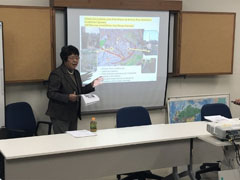 Ms. Yoneoka is introducing activities, including regional disaster risk reduction map production, which was initiated by residents in their association.
Ms. Yoneoka is introducing activities, including regional disaster risk reduction map production, which was initiated by residents in their association.
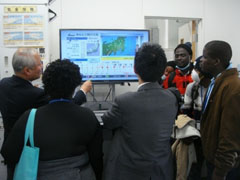 Mr. Hiroshi Mizokami in charge of risk management in Joso City Office is briefing efforts to advance weather and other knowledge for city officials.
Mr. Hiroshi Mizokami in charge of risk management in Joso City Office is briefing efforts to advance weather and other knowledge for city officials.
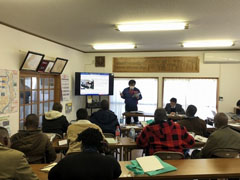 Mr. Ichiro Nagai from Shimodate River Office is explaining river improvement in the Kinu River and efforts to promote My Timeline.
Mr. Ichiro Nagai from Shimodate River Office is explaining river improvement in the Kinu River and efforts to promote My Timeline.
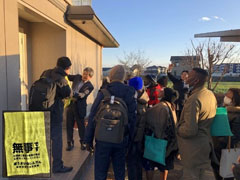 Chairman Hideo Suga is introducing efforts made by the neighborhood association (Efforts to make efficient safety confirmation system by using a towel saying "Buji-desu," meaning "I am safe" in Japanese).
Chairman Hideo Suga is introducing efforts made by the neighborhood association (Efforts to make efficient safety confirmation system by using a towel saying "Buji-desu," meaning "I am safe" in Japanese).
Understanding of disaster risk reduction countermeasures in Japan (Feb. 19, 2020)
In the morning, Ms. Kazuko Ishigaki, in charge of disaster risk reduction in the Cabinet Office, lectured on the entire picture of Japanese disaster risk reduction countermeasures, including Disaster Countermeasures Basic Act and disaster management planning system. In the afternoon, Mr. Katsuhiko Murase, from the International Affairs Office, River Planning Division, Water and Disaster Management Bureau, Ministry of Land, Infrastructure, Transport, and Tourism, gave a lecture on Japan's efforts for disaster risk reduction countermeasures, mainly on flooding, inland flooding and storm surge.
The participants visited the Cabinet Office and attended the "Japan-Mozambique Public and Private Seminar for Disaster Risk Reduction," based on the framework of Japan International Public-Private Association for Disaster Risk Reduction (JIPAD) for the overseas deployment of disaster prevention technology. In the seminar, an opening remark was delivered by Mr. Ichiro Aoyanagi, who is responsible for disaster risk reduction in the Cabinet Office. Three private companies presented their disaster risk reduction technologies, and a total of 11 companies participated in the seminar.
Abdul who is in charge of emergency response at a disaster in Mozambique, has a high interest in Japan's disaster risk reduction efforts. He asked questions about the Japanese system for nearly 30 minutes, and the seminar time was extended for one hour. By learning Japan's disaster risk reduction efforts, the participants recognized that the countermeasures against disasters in Mozambique are insufficient. But they also gained confidence that the disaster risk reduction measures taken by Mozambique are in the right path, and they can implement activities step by step to improve it.
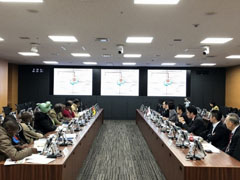 Lecture provided by Ms. Ishigaki in the "Japan-Mozambique Public and Private Seminar for Disaster Risk Reduction."
Lecture provided by Ms. Ishigaki in the "Japan-Mozambique Public and Private Seminar for Disaster Risk Reduction."
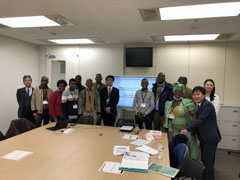 Group photo with participants after the lecture given by Mr. Murase from the Ministry of Land, Infrastructure, Transport and Tourism.
Group photo with participants after the lecture given by Mr. Murase from the Ministry of Land, Infrastructure, Transport and Tourism.
- Highlights -
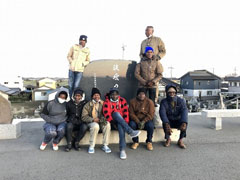 Commemorative photo with the monument for levee collapsing, built in the levee for the Kinu River in Joso City.
Commemorative photo with the monument for levee collapsing, built in the levee for the Kinu River in Joso City.
Participants get some ideas from his monument and worked on installing the monumental stone in Beira City just two weeks after they returned home (see post-training section for details).
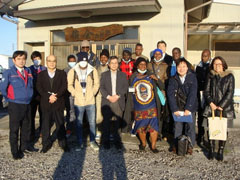 Commemorative photo in front of the community center for Neshinden Neighborhood Association. The Association Head Mr.Suga, who has a fascinating personality, delivered a closing remark, saying that "the world is all one, and we should work together" and "see you again in Mozambique!"
Commemorative photo in front of the community center for Neshinden Neighborhood Association. The Association Head Mr.Suga, who has a fascinating personality, delivered a closing remark, saying that "the world is all one, and we should work together" and "see you again in Mozambique!"
- About JICA
- News & Features
- Countries & Regions
- Our Work
- Thematic Issues
- Types of Assistance
- Partnerships with Other Development Partners
- Climate Change / Environmental and Social Considerations
- Evaluations
- Compliance and Anti-corruption
- Science and Technology Cooperation on Global Issues
- Research
- JICA Development Studies Program / JICA Chair
- Support for the Acceptance of Foreign HRs / Multicultural and Inclusive Community
- Publications
- Investor Relations
